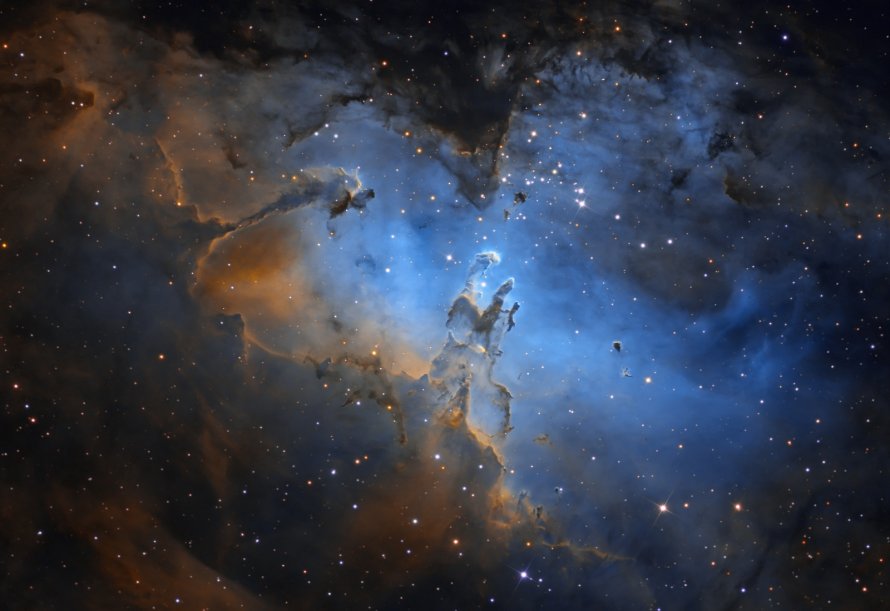M16 (NGC 6611) - Eagle Nebula
Messier 16 (NGC 6611), also known as the Eagle Nebula, is an emission nebula located in the constellation Serpens Claudia, in the Sagittarius Arm of the Milky Way Galaxy in the Local Group of galaxies. M16 is 5700 light years away from Earth.
M16 is best viewed during late summer, is magnitude 6, and can be viewed with naked eye (barely). M16 is 70' x 50' in apparent size. For reference, the full moon is 30'.
Observing difficulty: Easy
- Name:
- Eagle Nebula
- Alt name:
- Star Queen nebula
- Type:
- emission nebula
- Constellation:
- Serpens Claudia
- NGC or IC:
- NGC 6611
- Magnitude:
- 6
- Viewing:
- naked eye (barely)
- Size:
- 70' x 50'
- Distance (light years):
- 5700 LY
- RA:
- 18h 18.8m
- Dec:
- -13 47'
- Season:
- late summer
- Milky Way location:
- Sagittarius Arm
- Galaxy group:
- Local Group
- Messier Marathon #:
- 90
- Contains:
- Pillars of Creation
* The naked eye can see up to magnitude ~7-8 objects under ideal dark sky conditions.
The Eagle Nebula's Majestic Expanse
The beauty of our cosmos is aptly captured in Messier 16 (M16), more commonly known as the Eagle Nebula. This majestic region of active star formation lies in the constellation Serpens and is famous for its intriguing structures of interstellar gas and dust, including the iconic "Pillars of Creation". In this article, we will explore M16's discovery, physical properties, and its stunning features, discussing its brightness, and providing tips on how to locate and observe it.
Discovery and Observation
M16 was discovered by the Swiss astronomer Jean-Philippe Loys de Ch?seaux in 1745-46. However, it was later cataloged by Charles Messier in 1764. M16 is located about 7,000 light-years away from Earth and presents a fascinating sight with a small telescope or even binoculars, where it appears as a hazy patch of light surrounded by a rich star field.
Physical Characteristics and Magnitude
M16 is a vast region of star-forming gas and dust spanning approximately 70 light-years across. At the heart of the nebula lies an open cluster of young, hot stars that illuminate and shape the surrounding nebula. M16 shines at an apparent magnitude of 6.0, which is at the limit of naked-eye visibility under optimal viewing conditions. However, a modest pair of binoculars or a small telescope will significantly enhance the viewing experience.
Stellar Composition
The Eagle Nebula is a fertile breeding ground for new stars. Intense ultraviolet radiation from its hot, young stars excites the surrounding hydrogen gas, causing it to glow and creating the beautiful, luminescent quality we associate with emission nebulae. One of the most iconic regions within M16 is the "Pillars of Creation," towering columns of gas and dust where new stars are being born.
Astronomical Significance
The Eagle Nebula holds an esteemed place in astronomical research due to its active star-forming regions, providing valuable insights into the processes of star birth and early stellar evolution. The famous Hubble Space Telescope images of the "Pillars of Creation" have not only captivated public imagination but have also sparked extensive scientific study on the nature of these structures.
Finding and Viewing M16
Finding M16 involves locating the constellation Serpens, which is best seen in the summer months for those in the Northern Hemisphere. M16 is situated near the borders of Scutum, Sagittarius, and Serpens Cauda. Through a small telescope or binoculars, you'll observe a hazy region punctuated by stars. While the "Pillars of Creation" are not visible through amateur telescopes, their location adds a layer of fascination to M16's observation.



